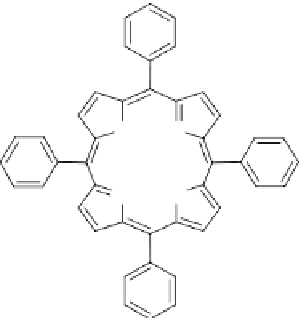Biomedical Engineering Reference
In-Depth Information
Fig. 22
Meso
-tetraphenyl
porphyrin, TPP
NH
N
N
HN
and
Staphylococcus epidermis
. The grafted particles were shown to be more effi-
cient than free RB in inactivating gram-positive bacteria, with a two orders of
magnitude reduction in the viability count.
pH-responsive silica nanoparticles for controllable
1
O
2
generation have been
developed by Zhang and collaborators (Li et al.
2010b
). A hydrophobic photosen-
sitizer (meso-tetraphenyl porphyrin, TPP, Fig.
22
) and a pH indicator (Bromocresol
Purple or Bromothymol Blue) were simultaneously encapsulated in 50 nm diameter
organically modified silica nanoparticles
via
an oil-in-water microemulsion
method. Both covalently encapsulated pH indicators have pKa values near the
physiological pH (6.4 and 7.1 respectively). It was demonstrated that, in basic con-
ditions (pH = 10.0), the encapsulated pH indicator absorbed light competitively and
thus restricted sensitizer excitation. In acidic conditions (pH = 5.0), the blue shifted
absorption of the pH indicator allowed the efficient excitation of the sensitizer. The
photodynamic activity of the encapsulated TPP was proved using the chemical trap-
ping of AMDA. The decrease in absorbance values of AMDA at pH = 5 is 6.3 times
larger than at pH = 10 after 90 min irradiation, which underlines the difference of
photodynamic activity between acidic and basic conditions. Interstitial fluid of dif-
ferent kinds of tumors is known to have a lower pH (6.15-6.80) than normal tissue
(7.0-7.4), which makes it a good target for a potential clinical application of this
system as a more specific anticancer drug.
Rossi and collaborators have covalently encapsulated PpIX by coupling the acid
groups with aminopropyltriethoxysilane (Rossi et al.
2008
) (Fig.
23
). The Stöber
procedure was used and led to particles of 77 ± 12 nm.
1
O
2
generation was charac-
terized by its phosphorescence spectra at 1,270 nm and by reaction with DPBF. The
efficiency of
1
O
2
generation in acetonitrile was determined to be 0.90 ± 0.06 for the
nanoparticles. This efficiency was higher than the free porphyrin in CCl
4
solution
(
1
O
2
quantum yield of 0.77). These nanoparticles were not tested
in vitro
.
Prasad and collaborators first reported the covalent incorporation of PS mole-
cules into ORMOSIL nanoparticles (Ohulchanskyy et al.
2007
). Iodobenzyl-pyro-
silane (IPS, Fig.
24
), a precursor for ORMOSIL was synthesized with the linked PS
iodobenzylpyropheophorbide (IP).

Search WWH ::

Custom Search